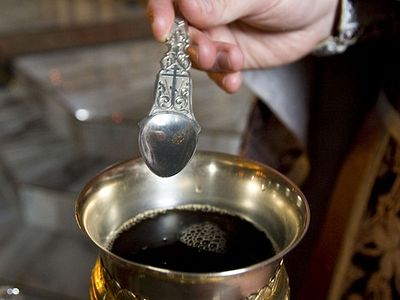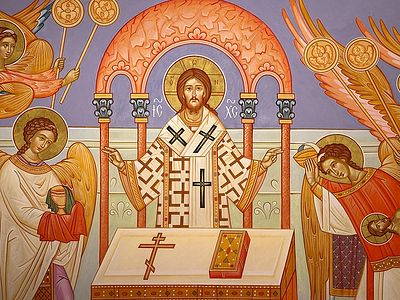Source: Orthodox Christian Network
November 26, 2016
When Jesus had spoken these words, He lifted up His eyes to heaven and said, “Father, the hour has come; glorify Thy Son that the Son may glorify Thee, sine Thou hast given Him power over all flesh, to give eternal life to all whom Thou hast given Him. And this is eternal life, that they know Thee the only true God, and Jesus Christ whom Thou hast sent. John 17:1-3
The servant of God (name) partakes of the Body and Blood of Christ, for the remission of sins and life eternal. Amen. (The Divine Liturgy of St. John Chrysostom, Holy Cross Seminary Press, 2016 Translation)
We’ve discussed many times why we receive Holy Communion. In today’s reflection we will discuss how to receive Communion, both from a practical and spiritual perspective. First, the decision to receive Communion should be made well in advance of the call to receive given by the priest. Second, the decision to receive Communion is just that, a decision, that one makes with careful consideration. We are not supposed to hear the words of invitation to Communion and just “go” because they are said. We know that the invitation is coming, so we should prepare to receive Communion well in advance of the Divine Liturgy.
In many communities, the Communion line on Sundays is long. While waiting in line, you should recite the prayer of the Penitent Thief, which is also the last line of the Communion prayers, “Lord, remember me when You come into Your kingdom.” (Luke 23:42) Holy Communion is not only preparation for God’s Kingdom, it is a foretaste of it. In receiving Communion, we become one with God for a finite moment. In heaven, we will be united with God for eternity.
What else can one do during the long wait for Communion? If you have already received, you can pray the “after Communion Prayers”. You can also pray for those who are receiving, either by name, or in general terms. Everyone who is receiving has a different reason—some are hopeful, others need hope, some are lost, some need forgiveness, some need strength, and so on. In praying for those who are receiving, we are showing love for our neighbor. In receiving ourselves, we are showing love for the Lord. This time of Communion, which can be half an hour or longer in some parishes, can be used as a time of personal retreat, to pray to the Lord on your own behalf, as well as for those who are receiving. In doing this, we fulfill the two great commandments, to love God and to love one another.
Many people complain about how long it takes for everyone to receive Communion. If you are using this time prayerfully, it will make it more meaningful.
The choir, during Communion, usually chants the last of the pre-Communion prayers:
Receive me today, Son of God, as a partaker of Your mystical Supper. I will not reveal Your mystery to Your adversaries. Nor will I give You a kiss as did Judas. But as the thief I confess to You: Lord, remember me in Your kingdom.
Sometimes, they also sing a Psalm, like this adaptation of Psalm 136:
O give thanks unto the Lord, for He is good. Alleluia. For His mercy endureth forever. Alleluia.
O give thanks unto the God of God, Alleluia. For His mercy endureth forever. Alleluia.
O give thanks unto the Lord of Lord. Alleluia. For His mercy endureth forever. Alleluia.
The verses continue in this way, with everyone singing the refrain. You can sing along with the choir as well. It will make the time more prayerful.
As a priest, when I distribute Communion, I try to not be so rushed that the person receiving can’t hear the prayer I am offering for them. I used to go faster, until someone pointed out how much they anticipated Holy Communion each week and what a special moment it is for them. This caused me to slow down a little to try to create a special moment for each person to receive.
The other thoughts I have as I am distributing Communion are thoughts of safety. This is THE Body and THE Blood of Christ, and it needs to be treated with great reverence.
When the person before you is receiving, you should make the sign of the cross. You shouldn’t make the sign of the cross at the chalice, for fear of you hitting the chalice on accident. When you approach to receive, take the cloth and put it under your chin (or allow the altar boy assisting the priest to do that). The purpose of the cloth is so that if any particle of the Communion were to fall off the spoon, it would fall on the cloth and not on the floor. So, make sure there is no gap where that could happen by holding the cloth under your chin.
Say your Orthodox name even if the priest knows your name. The reason for this is two-fold. First of all, you are presenting yourself to the Lord as you did at your baptism. If your baptism was your entrance into the life of Christ, and Communion is your sustenance in that life, you present yourself to the Lord at Communion by using the name that was used at your baptism.
The second reason is a practical one. Priests forget names, especially when your legal name and Orthodox Christian name are not the same. Also, priests have minds that wander as well. I remember many years ago, a parishioner was suffering from cancer. He came up and received Communion and said to me immediately after receiving, “The doctor says I have only days to live, please come see me this week.” You aren’t supposed to make comments to the priest at Communion, but in this case, this comment stunned me, as I was hoping for this man to live a little longer. I started thinking about what he said, what he meant to me (we were friends), I started crying, and I couldn’t think about much else in that moment. I’ve had other days where a parishioner died early on a Sunday morning and I’m wrapped up in the emotion of that. On behalf of my brother priests, please say your name, even if we know it. It is your presentation of yourself to the Lord and also a practical help for us.
Open your mouth wide and allow the priest to put the spoon in your mouth. Close your mouth on the spoon. Here is where some people get a little nervous. Can’t disease be communicated through Holy Communion? The answer is no. This is the Body and Blood of Christ. There is no evidence of anyone getting sick from receiving Communion. After the Divine Liturgy, every priest consumes the remainder of the Holy Communion. That means, after putting the spoon in the chalice sometimes hundreds of times on a Sunday, the priest consumes whatever remains in the chalice. If hundreds of people receive Communion on a Sunday, the odds that someone is sick are very high. If Communion could spread disease, at a minimum, all the priests would be sick all the time.
I had an experience once where I offered Communion to a man who was very sick, in fact, he was septic. He was very contagious. I put a small amount of Communion on a small spoon and gave it to him. When I took the spoon back out, there was a small particle of the Body still on the spoon, so I put the spoon in my mouth and licked it off. A nurse saw this and yelled at me “Are you insane? This man is very contagious.” While I very much respect everyone who works in the hospital, in this case, I disagreed. I told her, “This is the Body and Blood of Christ, it harms no one.” And it didn’t harm me.
After you receive Communion, wipe your mouth with the cloth, and make the sign of the cross as you walk away from the chalice. Take a piece of antithoron (blessed bread) and eat it. The purpose of the antithoron is to “break your fast” by giving you some food to eat and also to make sure none of the Communion remains in your mouth. If you received Communion and then sneezed, perhaps a particle of Communion would come out of your mouth. The antithoron assured that none of the Communion is left in your mouth.
The formula that the priest uses as he distributes Communion is the same for each person who receives.
The servant of God—We are all identified in the same way, as servants of God. (Your name)—The only thing that distinguishes us from one another in receiving Communion is our names. The priest doesn’t offer any other qualification or distinction. He doesn’t say “Eleni, the mom,” or “Thomas, the doctor,” or “George, the college graduate.” Only our name. The only exception to this is that when a priest receives from another priest, the priest distributing Communion says “George, the priest.” When the priest receives on his own, he says “The precious Body of Christ is given to me Stavros, the most unworthy priest.” When Communion is offered to the priest’s wife, whom we call “Presbytera” the priest will say “The servant of God Elizabeth, Presbytera, partakes of the Body and Blood of Christ.”
For remission of sins and life eternal—the purpose for receiving Communion is two-fold and we are reminded of this each time we receive. We receive as part of our continual repentance of our sins. We are supposed to be repenting. Christ, through continuous Communion, wipes out our sins. Communion is also supposed to help us prepare for eternal life. Again, these two concepts are very hard to grasp. So, first we learn to “do” the church by learning the appropriate mechanics of receiving and also worshipping at the Liturgy. As we learn and grow, we are supposed to eventually “be” the church, living a life in Christ that is a life of continual repentance, and continual looking towards our salvation. Holy Communion is the chief aid in our Christian life.
After receiving Communion, as the priest finishes “for remission of sins and life eternal” this prayer ends as all prayers do, with the word “Amen.” And even though the priest usually says this word, it should be said by all those who receive. Because “Amen” means “Let it be so.” If the priest has prayed for you to have “remission of sins and life eternal,” you should respond with an “Amen”, praying to God this this be so.
Lord Jesus Christ, my God, let Your sacred Body be unto me for eternal life and Your precious Blood for forgiveness of sins. Let this Eucharist be unto me for joy, health and gladness. And in Your awesome Second Coming make me, a sinner, worthy to stand at the right hand of Your glory; through the intercessions of Your pure Mother and of all Your saints. Amen. (From the Thanksgiving Prayers following Holy Communion)
Plan to receive Holy Communion regularly!
+Fr. Stavros
Visit our site each day to read the Daily Devotion!
Photo credit: Sts. Kosmas & Damianos Greek Orthodox Church





